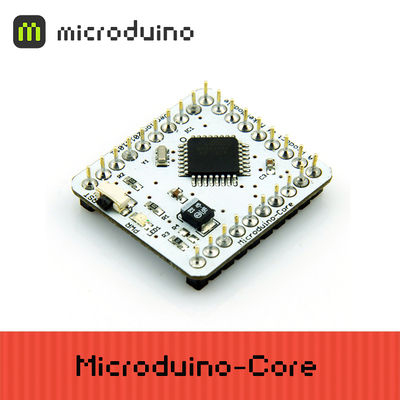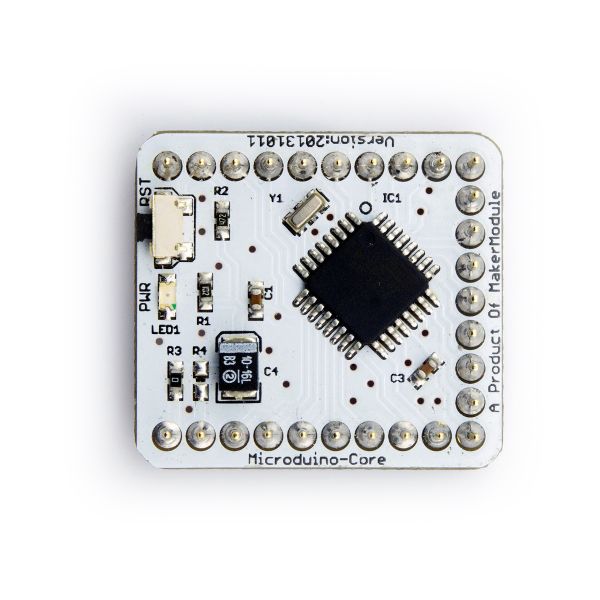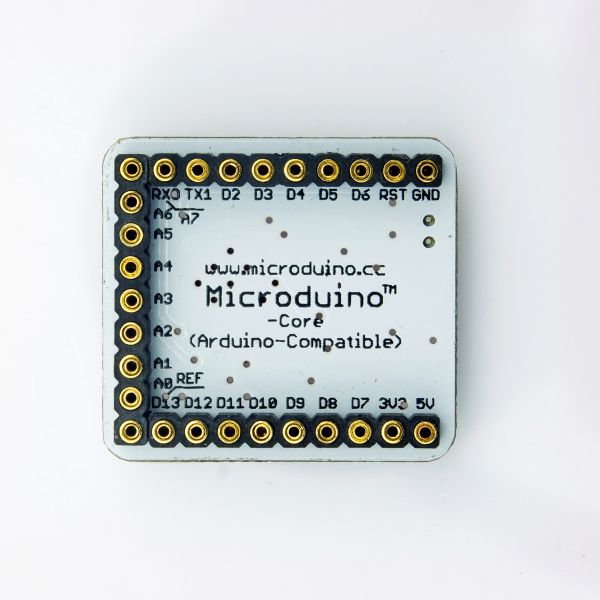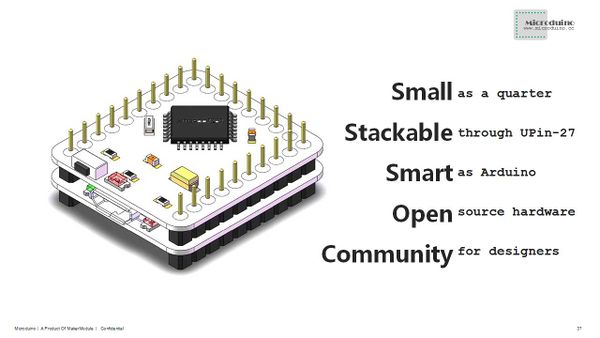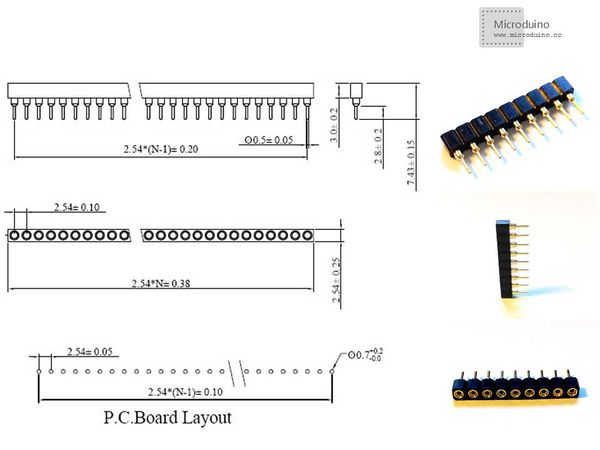“Microduino-CoreSTM32/zh”的版本间的差异
(→编程Microduino- CoreSTM32) |
|||
| 第1行: | 第1行: | ||
| − | {{Language|Microduino- CoreSTM32}} | + | {{Language|Microduino-CoreSTM32}} |
{| style="width: 800px;" | {| style="width: 800px;" | ||
|- | |- | ||
| | | | ||
| − | [[file:Microduino- | + | [[file:Microduino-core -rect.jpg|400px|thumb|right|Microduino-Core]] |
| − | Microduino- | + | |
| + | '''[[Microduino-CoreSTM32]]''' is one of core modules of Microduino series, '''[[Microduino-CoreSTM32]]''' is an open source hardware and [http://leaflabs.com/docs/hardware/maple-mini.html Maple Mini] compatible. It is an 32-bit ARM Cortex-M3 development board, based on STMicroelectronics' STM32F103CBT6 chip. | ||
| + | |||
| + | |||
| + | ==Features== | ||
| + | * Small, Stackable, Strong | ||
| + | * Open source hardware, using the same development environment as Arduino IDE | ||
| + | * Using the U-Shape 27-pin interface (UPin-27), the standard interface of Microduino series | ||
| + | |||
| + | Microduino modules and sensors can be easily stacked and extended through it | ||
| + | * Delivered ready to plug in. | ||
| + | * 2.54mm (0.1 inch) pin pitch, compatible to bread board and hole board | ||
| − | |||
| − | |||
| − | |||
| − | |||
| − | |||
| − | |||
|- | |- | ||
| | | | ||
| − | == | + | ==Specifications== |
| − | + | * Microcontroller: STM32F103CBT6 | |
| − | * | + | * Speed: 72MHz |
| − | * | + | * Operating Voltage: 5V |
| − | * | + | * Core Voltage: 3.3V |
| − | * | + | * Flash: 128KB |
| − | * | + | * SRAM: 20KB |
| − | * | + | * Digital I/O Pins: 14 (of which 6 provide PWM output with D3,D5,D6,D9,D10 and D11) |
| − | + | * Analog Input Pins: 8 (2 more comparing to Arduino Uno) | |
| − | * | + | * DC Current per I/O Pin: 40 mA |
| − | * | + | * DC Current: 50 mA |
| − | * | + | * Serial: 0 (RX) and 1 (TX). Used to receive (RX) and transmit (TX) TTL serial data. |
| − | + | * External Interrupts: 2 and 3. These pins can be configured to trigger an interrupt on a low value, a rising or falling edge, or a change in value. See the attachInterrupt() function for details. | |
| − | + | * PWM: 3, 5, 6, 9, 10, and 11. Provide 8-bit PWM output with the analogWrite() function. | |
| − | + | * SPI: 10 (SS), 11 (MOSI), 12 (MISO), 13 (SCK). These pins support SPI communication using the SPI | |
| − | |||
| − | |||
| − | |||
| − | + | library. | |
| − | + | * TWI: A4 or SDA pin and A5 or SCL pin. Support TWI communication using the Wire library. | |
| − | ** | + | * AREF. Reference voltage for the analog inputs. Used with analogReference(). |
| + | * Flash Memory 32 KB (ATmega328P) of which 0.5 KB used by bootloader | ||
| + | * SRAM 2 KB (ATmega328P) | ||
| + | * EEPROM 1 KB (ATmega328P) | ||
| + | * Clock Speed 16MHz(5V) / 8Mhz(3.3V) | ||
| − | |||
| − | |||
| − | + | |- | |
| + | | | ||
| − | === | + | ==Documents== |
| − | * | + | * '''[[Microduino-Core]]''' Eagle source file 【'''[[media:Microduino-Core.zip|download]]'''】 |
| − | * | + | * '''[[Microduino-Core]]''' main chips and devices |
| + | ** MCU: '''[[media:ATmega168PA328P.pdf|ATmega168PA/328P]]''' | ||
| + | |- | ||
| + | | | ||
| − | ''' | + | ==Development== |
| + | * Microduino Arduino IDE Configuration | ||
| + | ** 1. Install Arduino IDE: Microduino use the same IDE as Arduino, please download Arduino IDE from 【'''[http://arduino.cc/en/Main/Software Arduino IDE official]'''】 and install it in your disk. (if you already have it, just skip this step). Please check Arduino IDE details from 【'''[http://arduino.cc/en/Reference/HomePage Reference]'''】 and 【'''[http://arduino.cc/en/Tutorial/HomePage Workshop]'''】. | ||
| + | ** 2. Patch Microduino package: Please download Microduino package for Arduino IDE from 【'''[[media:Microduino-hardware.zip|download]]'''】, and unzip is to {Your Arduino Install Driectory}/hardware directory. | ||
| + | ** Microduino Arduino IDE Reference workshop: 【'''[[Arduino IDE Microduino Configuration]]'''】. | ||
| + | ** 3. Programming: To upload program to Microduino-Core/Core+ through Arduino IDE, designers are recommended to use '''[[Microduino-FT232R]]''' module. | ||
| + | ** 4. Enjoy your Microduino journey! | ||
| − | + | * Burn Microduino BootLoader | |
| − | * | + | ** Bootloader burning is necessary if designers want to update Microduino-Core/Core+ firmware by themselves, designers can leaverage Arduino Uno or another burned Microduino-Core/Core+ to make a new one. |
| − | * | + | ** Microduino bootloader workshop: 【'''[[Burn Bootloader to Microduino-Core/Core+ with an Arduino]]'''】. |
| − | + | ** Bootloader is specified for different Microduino-Core/Core+ configurations, correct one must be selected during burning. | |
| + | ** Initial bootloader is designed for ATmegaX8 series optiboot, which occupies only 512 bytes flash. | ||
| + | |- | ||
| + | | | ||
| − | == | + | ==Applications== |
| − | *Microduino- | + | * room-Microduino |
| + | * obdii-Microduino | ||
| + | * pilot-Microduino | ||
| + | * green-Microduino | ||
| + | * music-Microduino | ||
| + | |- | ||
| + | | | ||
| + | ==Buy== | ||
| + | * Buy '''[http://www.microduino.cc/Modules/Microdoino%20Core%20Modules/Microdoino-Core Microduino-Core]''' | ||
| − | == | + | |- |
| + | | | ||
| + | ==History== | ||
| + | *2012/12/16: Published Microduino-Core patch for Arduino IDE | ||
| + | *2012/11/18: Optimized the first formal release, finalized Miroduino-Core configuration | ||
| + | *2012/11/06: Beta version. | ||
| − | == | + | |- |
| + | | | ||
| + | ==Pictures== | ||
| + | :[[file:Microduino-Core-t.JPG|thumb|600px|center|Microduino-core Front]] | ||
| + | <br style="clear: left"/> | ||
| + | :[[file:Microduino-Core-b.JPG|thumb|600px|center|Microduino-core Back]] | ||
| + | <br style="clear: left"/> | ||
| + | :[[file:Microduino-Core-3d.jpg|thumb|600px|center|Microduino-core 3D model]] | ||
| + | <br style="clear: left"/> | ||
| + | :[[file:Microduino-Core-Upin27.jpg|thumb|600px|center|Microduino-core Upin27 model]] | ||
| + | <br style="clear: left"/> | ||
|} | |} | ||
2014年7月14日 (一) 08:38的版本
| Language | English |
|---|
|
Microduino-CoreSTM32 is one of core modules of Microduino series, Microduino-CoreSTM32 is an open source hardware and Maple Mini compatible. It is an 32-bit ARM Cortex-M3 development board, based on STMicroelectronics' STM32F103CBT6 chip.
Features
Microduino modules and sensors can be easily stacked and extended through it
|
Specifications
library.
|
Documents
|
Development
|
Applications
|
Buy
|
History
|
Pictures
|
